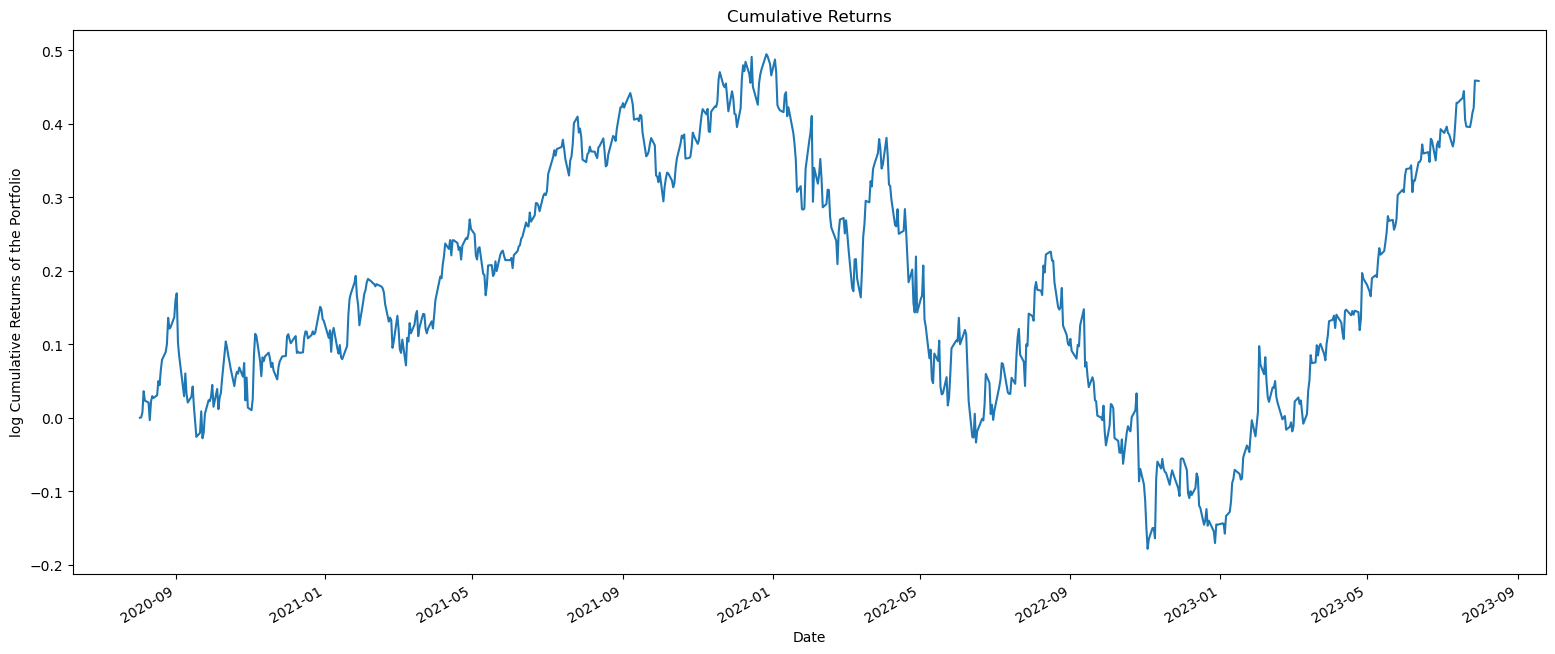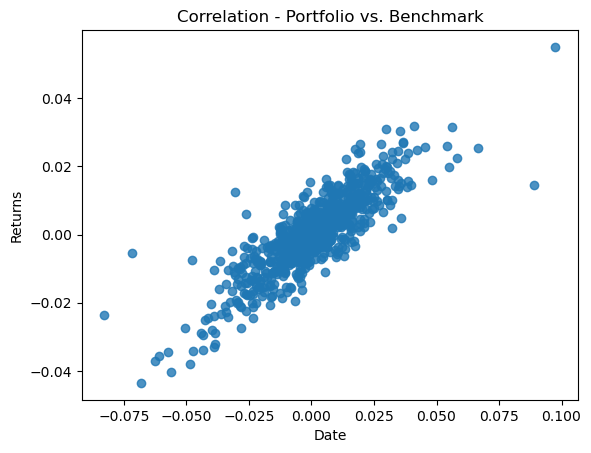Portfolio Analysis
Published:
We create a portfolio of stocks from American markets, analyze their performance and try to acess the risk in future.
Building the porfolio
We will build a tech dominant portfolio to analyze including companies like Apple, Microsoft, Google etc.
import yfinance as yf
import matplotlib.pyplot as plt
import numpy as np
import pandas as pd
# List of stock symbols
tech_stocks = ['AAPL', 'MSFT', 'AMZN', 'GOOGL', 'META']
# Set the date range for the historical data
start_date = '2020-08-01'
end_date = '2023-08-01'
# Download historical stock data for each stock
stocks = yf.download(tech_stocks, start_date, end_date)['Close']
[*********************100%%**********************] 5 of 5 completed
Portfolio construction
To assign the weight of each of the company stock we calculate the market capitalisation. To get the market value we need to know the last price of the security traded and the number of shares outstanding. yfinance gives the market cap directly.
For this, it is important to have a benchmark that can be used as a reference for the securities.
totalmp = 0
mcap=[]
for stock in tech_stocks:
# Create a Ticker object
# Create a Ticker object
ticker = yf.Ticker(stock)
# Fetch company information
company_info = ticker.info
# Get the market capitalization
market_cap = company_info.get('marketCap', None)
mcap.append(market_cap)
totalmp += market_cap
weights = [mc/totalmp for mc in mcap]
print(weights)
[0.3174813752091255, 0.2629812984283075, 0.1530503049106324, 0.18437709035962263, 0.08210993109231199]
Portfolio standard deviation
\[\sigma_{port} = \sqrt{w_{t}\Sigma w}\]\(\Sigma\) is covariance matrix and w’s are weights
# stock return
stocks_return = (stocks/stocks.shift(1))
# covariance of stocks
cov_matrix = stocks_return.cov()
# Annual portfolio covariance
cov_annual = cov_matrix * 252
# portfolio standard deviation
port_std = np.sqrt(np.dot(np.array(weights).T, np.dot(cov_annual, np.array(weights))))
print(f"portfolio standard deviation is {port_std*100:0.2f}%")
portfolio standard deviation is 30.35%
Portfolio returns
# get daily returns for each stock
stocks_return = stocks.pct_change()
# weighted portfolio return
weighted_returns_portfolio = stocks_return.mul(weights,axis = 1 )
# portfolio return
stocks_return[ 'Portfolio' ] = weighted_returns_portfolio.sum(axis = 1 )
stocks_return.head()
| AAPL | AMZN | GOOGL | META | MSFT | Portfolio | |
|---|---|---|---|---|---|---|
| Date | ||||||
| 2020-08-03 | NaN | NaN | NaN | NaN | NaN | 0.000000 |
| 2020-08-04 | 0.006678 | 0.008657 | -0.006380 | -0.008454 | -0.015009 | 0.000629 |
| 2020-08-05 | 0.003625 | 0.021091 | 0.003930 | -0.002842 | -0.001641 | 0.006640 |
| 2020-08-06 | 0.034889 | 0.006231 | 0.017484 | 0.064868 | 0.016014 | 0.028666 |
| 2020-08-07 | -0.024495 | -0.017842 | -0.004372 | 0.011912 | -0.017888 | -0.012410 |
# cummulative returns
cum_returns_porfolio = ((1 + stocks_return[ 'Portfolio' ]).cumprod()-1)
fig,ax = plt.subplots(1,1,figsize = (19,8))
cum_returns_porfolio.plot(ax=ax)
ax.set_title('Cumulative Returns')
ax.set_ylabel('log Cumulative Returns of the Portfolio')
ax.set_xlabel('Date')
plt.show()

Capital asset Pricing model
Its major assumptions are that the offer of financial assets is equal to the demand of financial assets.
Only deals with systematic risk (market risk), that can’t be reduced.
Excess Return = Return − Risk Free Return
\[E(R_p) − RF = \beta_p(E(R_m) − RF)\]- \(E(R_p) − RF\) = The excess in the expected return of Portfolio P
- \(E(R_m) − RF\) = The excess expected return of market portfolio
- RF = Risk-Free Return
- \(\beta_p\) = Beta of the portfolio
Currently US3Y yeild is 4.54% and inflation is 3.3%
# real risk free rate = RFR - infaltion
infaltion = 3.3
RFR = 4.54
real_rf = RFR - infaltion
stocks_return[ 'RF Rate' ] = real_rf/100.0
# Excess return
stocks_return['excess'] = stocks_return['Portfolio'] - stocks_return[ 'RF Rate' ]
Beta
The measurement of the systematic risk is through the beta, which is a degree of sensitivity that includes the variation of an asset compared with an index that is used as a benchmark.
\[\beta_p = \frac{cov(R_{p},R_{m})}{\sigma_m}\]# To calculate beta
stocks_return['Market'] = yf.download( 'SPY',start_date,end_date)['Close']
stocks_return['Market']=stocks_return['Market'].pct_change()
stocks_return.head().dropna()
[*********************100%%**********************] 1 of 1 completed
| AAPL | AMZN | GOOGL | META | MSFT | Portfolio | RF Rate | excess | Market | |
|---|---|---|---|---|---|---|---|---|---|
| Date | |||||||||
| 2020-08-04 | 0.006678 | 0.008657 | -0.006380 | -0.008454 | -0.015009 | 0.000629 | 0.0124 | -0.011771 | 0.003863 |
| 2020-08-05 | 0.003625 | 0.021091 | 0.003930 | -0.002842 | -0.001641 | 0.006640 | 0.0124 | -0.005760 | 0.006211 |
| 2020-08-06 | 0.034889 | 0.006231 | 0.017484 | 0.064868 | 0.016014 | 0.028666 | 0.0124 | 0.016266 | 0.006685 |
| 2020-08-07 | -0.024495 | -0.017842 | -0.004372 | 0.011912 | -0.017888 | -0.012410 | 0.0124 | -0.024810 | 0.000718 |
# Exess return of the market
stocks_return['excess market'] = stocks_return['Market'] - stocks_return['RF Rate']
stocks_return.head().dropna()
| AAPL | AMZN | GOOGL | META | MSFT | Portfolio | RF Rate | excess | Market | excess market | |
|---|---|---|---|---|---|---|---|---|---|---|
| Date | ||||||||||
| 2020-08-04 | 0.006678 | 0.008657 | -0.006380 | -0.008454 | -0.015009 | 0.000629 | 0.0124 | -0.011771 | 0.003863 | -0.008537 |
| 2020-08-05 | 0.003625 | 0.021091 | 0.003930 | -0.002842 | -0.001641 | 0.006640 | 0.0124 | -0.005760 | 0.006211 | -0.006189 |
| 2020-08-06 | 0.034889 | 0.006231 | 0.017484 | 0.064868 | 0.016014 | 0.028666 | 0.0124 | 0.016266 | 0.006685 | -0.005715 |
| 2020-08-07 | -0.024495 | -0.017842 | -0.004372 | 0.011912 | -0.017888 | -0.012410 | 0.0124 | -0.024810 | 0.000718 | -0.011682 |
# covariance matrix
covariance_matrix = stocks_return[[ 'excess', 'excess market' ]].cov()
covariance_matrix
| excess | excess market | |
|---|---|---|
| excess | 0.000365 | 0.000187 |
| excess market | 0.000187 | 0.000132 |
# covariane coeeficient
covariance_coefficient = covariance_matrix.iloc[0, 1]
# variance of market
variance_coefficient = stocks_return['excess market'].var()
# beta of the portfolio
beta = covariance_coefficient / variance_coefficient
beta
1.416897406000382
The beta demonstrates that the portfolio is more volatile than the market. The portfolio is 41% more volatile than the S&P 500. For every 1% of movement in the market there will be a 1.41% of rise or fall in the portfolio.
Sharpe Ratio
Higher ratio is better it is considered since the denominator is standard deviation or risk. It is used when comparing peers, for example in an exchange-traded fund (ETF)
\[Sharpe \ Ratio = \frac{R_p-R_f}{ \sigma_p}\]- \(R_p\) = returns of the portfolio
- \(R_f\) = risk-free rate
- \(\sigma_p\) = standard deviation of the portfolio excess returns.
# plot returns of porfolio and market
CumulativeReturns = ((1 + stocks_return[[ 'Portfolio','Market' ]]).cumprod()- 1 )
CumulativeReturns.plot(figsize = ( 16,4 ))
_ = plt.ylabel( 'Returns' )
_ = plt.title( 'Comparison - Portfolio vs. Benchmark' )
_ = plt.xlabel( 'Date' )
plt.show()

# plot scatter plot for correlation
plt.scatter(stocks_return[ 'Portfolio' ],stocks_return[ 'Market'],alpha = 0.80 );
_ = plt.ylabel( 'Returns' )
_ = plt.title( 'Correlation - Portfolio vs. Benchmark' )
_ = plt.xlabel( 'Date' )

# get the two columns in a dataframe
portfolio_benchmark = stocks_return[[ 'Portfolio','Market']].dropna()
# get correlation
portfolio_benchmark.corr()
| Portfolio | Market | |
|---|---|---|
| Portfolio | 1.000000 | 0.851744 |
| Market | 0.851744 | 1.000000 |
# get sharpe ratio
sharpe_ratio = ((stocks_return[ 'Portfolio' ].mean() - stocks_return[ 'RF Rate' ].mean()))/stocks_return['Portfolio' ].std()
print("Sharpe ratio is ",sharpe_ratio)
print("Sharpe ratio annual ",sharpe_ratio*np.sqrt(252))
Sharpe ratio is -0.6131452933469881
Sharpe ratio annual -9.73337978247526
SR is negative, indicates that mean return of the portfolio is smaller than the risk-free rate. Therefore the portfolio is not effective
Traynor ratio
Higher TR is a result of the portfolio management. When analyzing the Traynor Ratio, if it is negative, the portfolio has underperformed the risk-free rate.
\[Traynor Ratio = \frac{R_p - R_f}{\beta_p}\]- \(R_p\) = returns of the portfolio
- \(R_f\) = risk-free rate
- \(\beta_p\) = Beta of the portfolio
# covariance
covariance = stocks_return.cov() * 252
# covariance between market and portfolio
covariance_market_portfolio = covariance.at['Market','Portfolio']
# variance of market
market_variance = stocks_return[ 'Market'].var() * 252
# beta of the portfolio
portfolio_beta = covariance_market / market_variance
traynor_ratio = ((stocks_return['Portfolio'].mean() - stocks_return['RF Rate'].mean()))/portfolio_beta
traynor_ratio
-0.008268904314486599
TR is negative, which means that the port- folio is not performing better than the risk-free rate. Main difference between the Sharpe and the Traynor ratio is that it compares with the beta and not the volatility
Jensen’s measure
Measuring the relationship between the return of the portfolio in comparison with another portfolio return with the same risk, same reference market and under the same parameters.
\[\alpha = R_p - (R_f + \beta_p(R_m-R_p))\]# get covariance of between market and portfolio
annual_return = stocks_return
covariance = annual_return[[*tech_stocks,'Portfolio','Market']].cov()*252
covariance
| AAPL | MSFT | AMZN | GOOGL | META | Portfolio | Market | |
|---|---|---|---|---|---|---|---|
| AAPL | 0.093153 | 0.064348 | 0.074747 | 0.064086 | 0.081080 | 0.079273 | 0.044044 |
| MSFT | 0.064348 | 0.084440 | 0.076880 | 0.070369 | 0.082589 | 0.073578 | 0.042132 |
| AMZN | 0.074747 | 0.076880 | 0.142706 | 0.081007 | 0.110047 | 0.100261 | 0.049349 |
| GOOGL | 0.064086 | 0.070369 | 0.081007 | 0.102456 | 0.100217 | 0.081586 | 0.044204 |
| META | 0.081080 | 0.082589 | 0.110047 | 0.100217 | 0.232736 | 0.119713 | 0.054172 |
| Portfolio | 0.079273 | 0.073578 | 0.100261 | 0.081586 | 0.119713 | 0.092012 | 0.047174 |
| Market | 0.044044 | 0.042132 | 0.049349 | 0.044204 | 0.054172 | 0.047174 | 0.033294 |
# covariance market
covariance_market = covariance.at['Market','Portfolio']
# variance of market
market_variance = stocks_return[ 'Market' ].var() * 252
# beta of the portfolio
portfolio_beta = covariance_market/market_variance
# portfolio return
portfolio_return = stocks_return['Portfolio' ].mean()
# RFR
risk_free_rate = stocks_return['RF Rate'].mean()
# alpha
alpha = portfolio_return - (risk_free_rate + portfolio_beta*(portfolio_return - risk_free_rate))
alpha
0.004884448833019478
